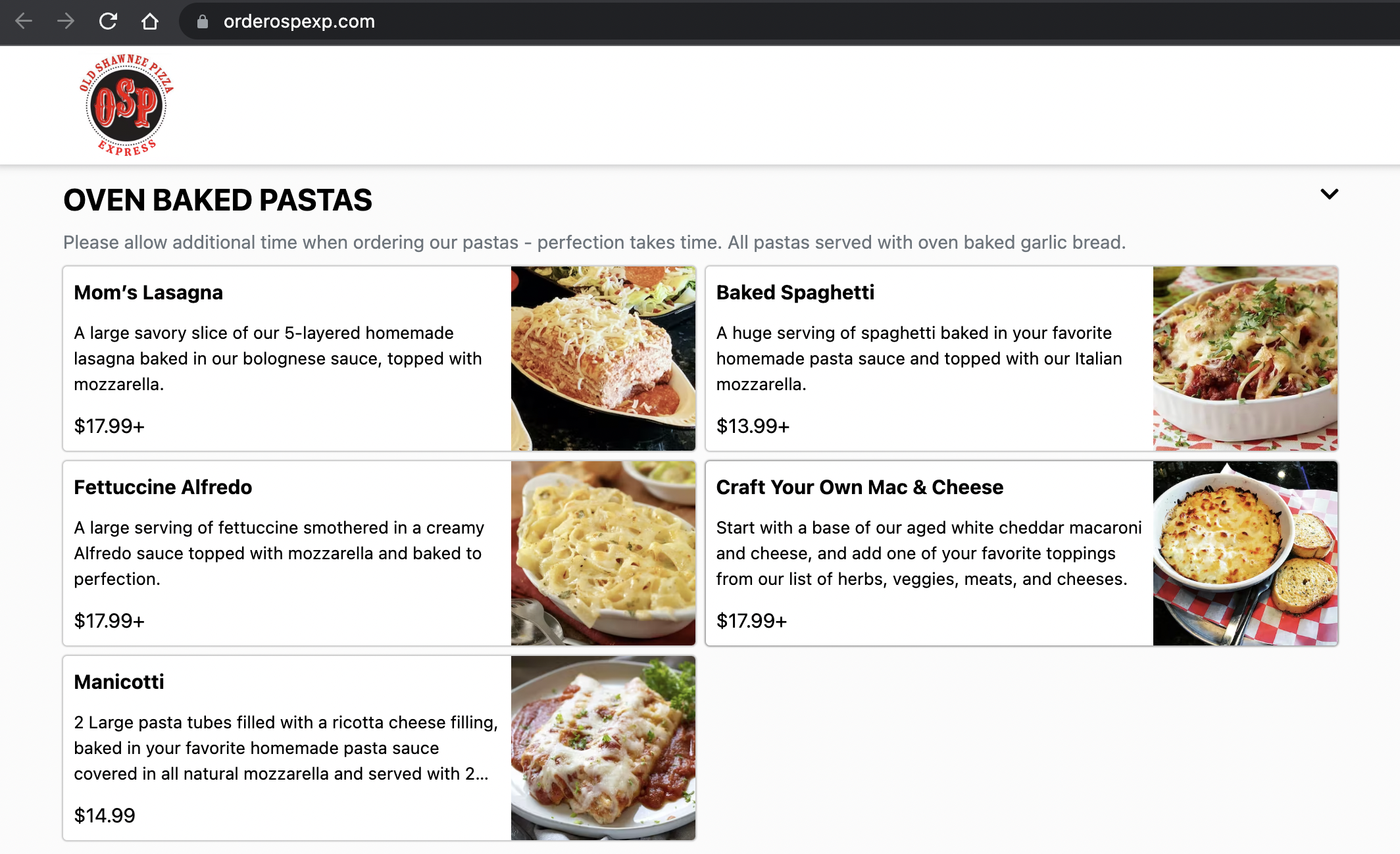Restaurant owners who can give customers what they want will always see a high return on their investment. And we're not talking about the quality of food or service.
Every month we receive feedback from countless online ordering customers, many of whom request one thing:
Menu item descriptions.
See what actual customers are saying.
"Descriptions of what exactly comes on which pizza would be really appreciated instead of having to guess how each different restaurant does their white pizza."
-James S. 3/8/23
"It would really help if you had descriptions of everything - for those of us not familiar with the cuisine. I had to google everything. That said, I am looking forward to trying your food."
-Charles M. 3/6/23
"Would be nice to have a description of the entrees when ordering. I wanted to try something new but didn’t see any description."
-Patricia A. 2/21
Customers who are on your restaurant's online ordering site are already interested in the food. So why not enhance their experience by adding descriptions of your delicious dishes?
Tantalizing food descriptions can influence someone to try something new or add more to their order.
Menufy by HungerRush associates are restaurant success experts and have experience crafting effective dish explanations. Read on to learn why they think menu descriptions are important and find out what tips they have for creating your own.
Why do menu items need descriptions?
Our experts have countless reasons why restaurant owners should consider adding a bit of text to food items on their online menus.
Meet Expectations
One of Menufy's veteran associates, Taylor Moon, has worked for years optimizing websites and improving the online presence of our restaurant partners. He shared his thoughts about menu descriptions from a customer's perspective:
"It is very important for a menu to have item descriptions because I want to know what I'm ordering and am going to eat! I will more likely order something that is described well so that when I get the food, there are no surprises and my expectations for what I ordered are met."
allergies & taste preferences
Katrina Simmons spends her workdays organizing restaurant data on online ordering sites. She knows firsthand the importance of sharing dish explanations with customers:
"Customers like to know what's included on items so they can request that specific ingredients be removed due to allergies or taste preferences. Item ingredients can vary from restaurant to restaurant, so a garden salad at one place might be completely different from a garden salad at another place. Customers are just more likely to place orders if they know exactly what comes on the food they're ordering."
Customer Confidence
Designer Erin Trampel has created hundreds of websites for Menufy's restaurant partners. She recognizes that food descriptions benefit the restaurant and customer:
"Having descriptions on your menu items helps in a couple of ways. It increases your search engine ranking because you have more searchable text on the website, and it builds consumer confidence by showing customers exactly what to expect."
The consensus is that menu descriptions help your restaurant stand out online and give your customers even more of a reason to click "add to cart."
Old Shawnee Pizza Express has perfected the item descriptions for their baked pastas.
The recipe for a great dish description.
A basic menu description will usually list the main ingredients in a dish, but we think descriptions can do much more than that. Our restaurant experts suggest six topics to consider when crafting the story of a menu item.
1. Ingredients
The hero of every description should be the main ingredients used in the preparation of your dish. There's no need to list the entire recipe. Just focus on the components that contribute the most to the dish's flavor. If certain ingredients have multiple varieties, such as cheese, pasta, and veggies, make sure to state the specific type.
For customers who are vegan or have diet restrictions or food allergies, the ingredient list is vital to making an informed decision. We recommend identifying common allergens (which can be found on the FDA website) to ensure a safe and welcoming experience for every customer.
Also, patrons are always tempted by local, well-known, or exotic ingredients. This is your chance to showcase what makes your dish components unique!
Tip: If the Menufy online ordering experts have a list of dish ingredients, they can create a list of default ingredients on items such as pizzas so customers can easily de-select anything they don't want.
Example
Bad: Greek burger
Better: Burger topped with feta cheese
Best: 6-oz. KC Beef Co. Black Angus beef patty, grilled to order. Topped with tangy Green Dirt Farm feta, tzatziki, and sweet red onions.
2. Quantity
When you leave out the proportions or quantity of a dish, you leave the customers guessing. Prevent patrons from being disappointed by sharing the serving size (this includes ounces!) for items on your menu.
Example
Bad: Crab rangoon
Better: Six crab rangoons, served with sweet and sour sauce
Best: Six fried wontons filled with a mixture of fresh crab and cream cheese, served with house-made sweet and sour sauce for dipping
Nourish Juice Bar + Kalos Coffee Co. does a great job at succinctly describing their cappuccino.
3. Cooking or Preparation Method
There are many ways to prepare the same dish. For instance, pizza can be grilled, oven-baked, or wood-fired. This is why restaurant owners should consider including the cooking method for certain menu items.
Example
Bad: Steak and fries
Better: Strip steak and french fries, served with butter
Best: Fire-grilled 9-oz. KC strip and crispy, hand-cut fries, served with a melted butter dipping sauce
Epic Burger’s use of preparation techniques makes this dish even more mouthwatering.
4. Tasty Adjectives
Each description should paint a tasty picture that describes the textures and taste of the dish. Words like "tender," "creamy," and "crispy" make customers even hungrier!
Example
Bad: Pepperoni pizza
Better: Thin-crust pepperoni pizza with red sauce
Best: Crispy 10" thin-crust pizza, wood-fired and topped with a savory tomato sauce, mountains of mozzarella cheese, and crackling pepperoni
5. Share the Story
People love a good backstory. If a dish is made from a recipe that has been around for generations, your customers want to know! Sharing a short history or anecdote is a great way to engage customers and make your menu item stand out.
Example
Bad: Arepas
Better: Venezuelan arepas stuffed with spicy beef
Best: Our Venezuelan arepas, from a 40-year-old family recipe, feature a rich mix of tender shredded beef and sweet chile, stuffed into a warm cornmeal cake.
Max’s highlights the Filipino roots of this menu item.
6. To the Point
If your menu item explanation begins to look like a novel, you've gone too far. Effective food descriptions should be short and sweet. A lengthy and rambling description may cause the customer to move on from ordering that item.
Example
Bad: Italian-inspired meatballs that will remind you of Italy. They are seasoned with salt, pepper, oregano, basil, and garlic. The meatballs are cooked in our oven at 350 degrees for 35 minutes. Then we put parmesan cheese on the meatballs. We serve them with marinara sauce that will also remind you of Italy. The sauce is made with tomatoes and is seasoned with garlic, onion powder, salt, pepper, and basil. We suggest dipping the meatballs into the marinara sauce.
Better: Meatballs and marinara sauce seasoned with Italian spices
Best: Four huge Italian meatballs, hand-rolled and oven roasted, garnished with parmesan cheese. Served with our freshly-made signature marinara sauce.
The final ingredient.
Mouthwatering dish descriptions don't just improve your menu's sell-ability, they also improve the ranking of your restaurant online. Menu item explanations are essential to increasing customer interest and brand awareness.
Writing menu descriptions doesn't have to be a headache if you follow our easy tips. Simply highlighting a dish's unique ingredients and how the food is prepared can persuade a hungry customer to order online from your restaurant!
ABOUT THE AUTHOR
Melissa Dimmitt, Marketing Manager
Melissa began her digital marketing career over a decade ago at a restaurant group. She worked with restaurant managers and executive chefs while coordinating seasonal menu releases, executing photoshoots, and creating fresh digital content.






